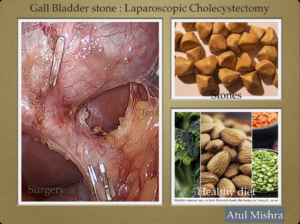
Gall bladder is a small organ below liver in the right side of upper abdomen. It is a pouch that stores bile, a green-yellow liquid that helps with digestion of fat.
Causes of stone formation:
80% of gall stones are made of cholesterol and 20% are made of calcium salts and bilirubin.
Having excess cholesterol in bile can lead to yellow, hard cholesterol stones. It may develop when liver makes more cholesterol than bile can dissolve.
Bilirubin is a chemical produced when liver destroys old red blood cells. Some conditions causing liver damage and certain blood disorders cause liver to produce more bilirubin. Pigment gall stones form when gall bladder can’t breakdown the excess bilirubin. These stones are dark brown or black.
Healthy and properly functioning gall bladder should empty bile regularly. If it fails to empty, the bile becomes over concentrated causing stone formation.
Symptoms:
Gall bladder stones can lead to pain in the upper right abdomen. Pain may start after intake of food high in fat, such as fried food. The pain usually lasts for a few hours.
It can also cause-
Nausea
Vomiting
Dark Urine
Clay colored stool
Stomach pain
Burping
Indigestion
Complications
Acute Cholecystitis
When a gallstone blocks the duct where bile moves from the gall bladder, it can cause inflammation and infection in the gall bladder.
Symptoms are: Intense pain in the upper stomach or mid-right back, fever, chills, appetite loss, nausea and vomiting.
Urgent medical consultation should be sought if symptoms last more than 1 to 2 hours.
Other complications:
Jaundice- Yellowish tint of skin or eyes
Cholangitis- Bile duct infection
Sepsis- blood infection
Pancreas inflammation
Gall bladder cancer
Risk factors for Gall Stones
Lifestyle
• Overweight (Obese)
• Eating diet high in fat or cholesterol, low in fiber
• Having rapid weight loss in a short period of time
• Diabetes Mellitus
Uncontrollable risk factors
• Female sex
• Family history of gall stone
• Age more than 60 years
Medical risk factors
• Cirrhosis of liver
• Pregnancy
• Medication for lowering cholesterol
• Medication high in estrogen content
Diagnostic Tests
Ultrasound
Abdominal CT scan
Gall Bladder Radionuclide Scan
Endoscopic Retrograde Cholangio Pancreatography (ERCP)
It is a procedure that uses camera and X-rays to look at the problems in the bile and pancreatic duct. It helps to remove gallstones stuck in bile duct.
Treatment
If gallstone is causing pain or other symptoms, surgery is recommended.
Laparoscopic Cholecystectomy
Surgical removal of gall bladder by minimally invasive key hole technique.
After gall bladder removal one may experience loose or watery stools. Removing the gall bladder involves rerouting the bile from the liver to small intestine. Bile no longer goes through the gall bladder and it becomes less concentrated. The result is a laxative effect that causes diarrhea. To treat this, a diet low in fat and high in fiber should be taken.
TIPS FOR HEALTHY GALL BLADDER
Life style changes in a patient having gallstone
• Maintain a healthy weight
• Avoid rapid weight loss
• Eat anti-inflammatory diet (Bell pepper, citrus fruits, green leafy vegetables, tomatoes, milk, fish, beans, nuts, lentils)
• Regular exercise
• Supplements – Vitamin C, Iron, Lecthin
Foods to avoid to reduce risk of gallstone
• Avoid high fat, greasy and fried foods
• Add fiber to your diet
• Avoid caffeinated drink, high-fat dairy produce and very sweet food
• Eat several small meals per day
• Drink sufficient amount of water (8-10 glasses /day)
You can watch a video of Laparoscopic Cholecystectomy for Gall Bladder stone done by Dr Atul Mishra on our You Tube Channel:




